27 APRIL – 5 MAY 2024
By Jacob Roalef
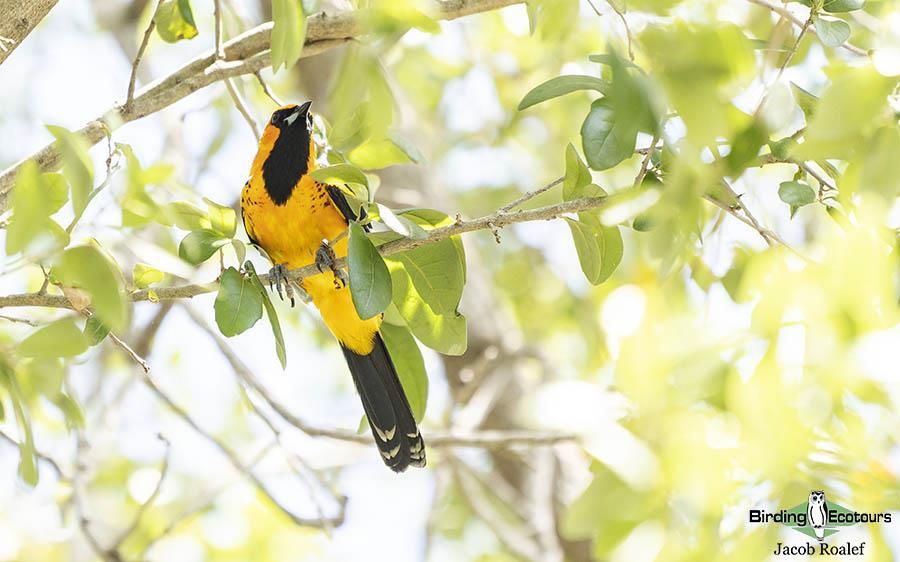
The beautiful Spot-breasted Oriole was the cherry on top of a great trip.
Overview
This nine-day birding adventure of Florida began in Miami with some exploration of the Atlantic Coast, crossed the state to Fort Myers on the Gulf side, then headed back along the southern edge and down throughout the Florida Keys, before circling back to Miami for the trip’s conclusion. The tour explored several different habitats and visited some amazing birding locations such as Wakodahatchee Wetlands, Loxahatchee National Wildlife Refuge, Babcock Webb Wildlife Management Area, Carlos Pointe, Everglades NP, Big Pine Key, Dry Tortugas NP, and Fort Zachary Taylor State Park.
We enjoyed many fantastic bird sightings which included a variety of specialty species, migrants, seabirds, and ABA countable introduced species, giving us a fine list for southern Florida, during our short nine-day visit. Avian highlights included Mangrove Cuckoo, Mottled Duck, Reddish Egret, White-crowned Pigeon, Limpkin, Sooty, Bridled and Roseate Terns, Black and Brown Noddies, Mitred and Red-masked Parakeets, Red-cockaded Woodpecker, Scaly-breasted Munia, Spot-breasted Oriole, Cape May Warbler, Black-whiskered Vireo and Snail Kite.
A total of 157 bird species were seen, plus two additional heard only species, for a total of 159 species recorded. In addition to the birds, several nice mammal and reptile sightings were had, which included West Indian Manatee, Marsh Rabbit, American Alligator, Florida Cooter, and the endangered subspecies of White-tailed Deer known as Key Deer. Full bird and mammal checklists can be found at the end of the report.
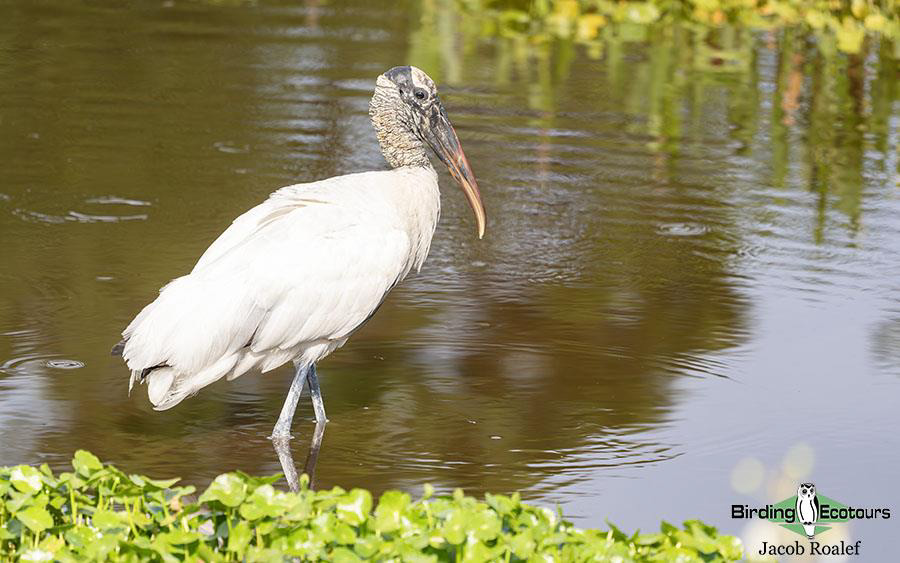
Wood Stork was seen throughout our tour of southern Florida.
Detailed Report
Day 1, 27th April 2024. Arrival in Miami
All participants arrived in Miami and were transferred to the hotel for check-in, to get settled after traveling. We met in the hotel lobby and headed off to our first dinner together. At dinner we got to know each other better and discussed the upcoming trip and plans. After some tasty food at a local Cuban restaurant, we returned to the hotel to rest, before an early start to our first full day tomorrow. Of course, we were searching for birds on the way back and picked up our first few species of the trip, including Grey Kingbird and Common Myna.
Day 2, 28th April 2024. Miami birding and Wakodahatchee Wetlands
Today we began with urban birding all around the Miami area, with a special focus on established exotic species that are countable on the official ABA list. Our first stop was Pine Woods Park, a small section of cut grass along some power lines. It wasn’t long before we had our first target of the day, Scaly-breasted Munia. While enjoying these tiny birds, our second target appeared in the bushes above them, Red-whiskered Bulbul, another exotic. This species can be tricky to locate at times, so it was great to nail one early on. In addition to these two, we picked up some of the more common native species like Fish Crow, Common Grackle, Red-bellied Woodpecker, and Blue Jay. After our nice morning walk, we headed off to several other Miami exotic spots. During these hours we picked up Egyptian Goose, Indian Peafowl, Mitred, Red-masked, and Yellow-chevroned Parakeets, and Muscovy Duck. We even added a non-countable exotic, Blue-and-yellow Macaw. While they aren’t on the official ABA list yet, they may be someday, and it is still neat to see these giants flying around a local park in Miami. With this, our exotic chasing around Miami was completed for the day, and it was time for a tasty local lunch.

Everyone loves the adorable Burrowing Owl.
After lunch we headed north and left Miami behind. Our first stop was a quick one, at a local sports park complex, to check on a resident population of the Florida subspecies of Burrowing Owl. We were treated to some stellar views of a family of these adorable owls, as well as some other nice species such as Monk Parakeet (another established exotic) and Loggerhead Shrike. From here we continued north to spend the rest of the afternoon at the wonderful Wakodahatchee Wetlands. This series of controlled water ponds and dikes is heaven for wading species, especially during breeding season. We walked the entire boardwalk, noting loads of fantastic species like Wood Stork, Little Blue and Tricolored Herons, Great and Cattle Egrets, Least Bittern, Purple and Common Gallinules, Mottled Duck, Anhinga, Glossy Ibis, Black-necked Stilt, and our final exotic of the day, Grey-headed Swamphen. Most of these species were observed at close range, and some even on nests and with babies. These wetlands were the perfect finish to our first full day of the trip. It was time for dinner and rest at the hotel.
Day 3, 29th April 2024. From Ocean to Gulf, crossing Florida
Today we had a lot of ground to cover, as the goal was to travel across the state and end up in Fort Myers. After an early breakfast we loaded up the vehicle and set out to our first stop of the day, Lake Ida Park. The birding was a bit slow this morning, but we did manage a few migrants like Northern Parula and Cape May Warbler, plus a couple other species, including Limpkin and Royal Tern. From here we pressed onwards to Loxahatchee National Wildlife Refuge and took a peaceful walk around their cypress swamp boardwalk. Here we picked several new trip birds, like Sandhill Crane, Carolina Wren, and Snowy Egret. The forecast today was looking spotty for rain and, just as we loaded back up, the storms came. Our visit to a nearby wetlands turned up a cute family of Wood Ducks, but didn’t last long because the rain came quickly. We made a dash for the vehicle and headed to lunch to wait out the storm.
After lunch the storm had passed, and we began our journey westward across the swamps of Florida. We made a quick stop at a wastewater treatment facility and managed to find some very distant Fulvous Whistling-Ducks, along with Red-winged Blackbird and Pied-billed Grebe. As we continued our long journey, we picked up several other new trip species, like Red-shouldered Hawk, Tree Swallow, and Brown-headed Cowbird. Eventually we made it to Western Florida and began our search for the endemic Florida Scrub-Jay. In recent years this species has been reliable in a nearby neighborhood and today was no different as we scored nice views of two individuals. We were then off to our final location of the day, Harns Marsh. Soon after exiting the vehicle, we scored our top target for this location, the Florida special, Snail Kite. Our views were a bit distant, however, so we hiked along hoping for some closer views. In the nearby pine forest, we found some other new species like Pileated Woodpecker, Great Crested Flycatcher, Palm Warbler, and Blue-grey Gnatcatcher. We managed to see another distant kite and got a sense of its location and behavior pattern. We loaded back up and found a section of the road crossing a canal, that the kites were hunting over. Here we were treated to much closer views of both a male and female Snail Kite and we even saw one pull up and eat a large Apple Snail! After this great success, we called it a day and checked into our hotel and enjoyed a tasty Italian dinner together.
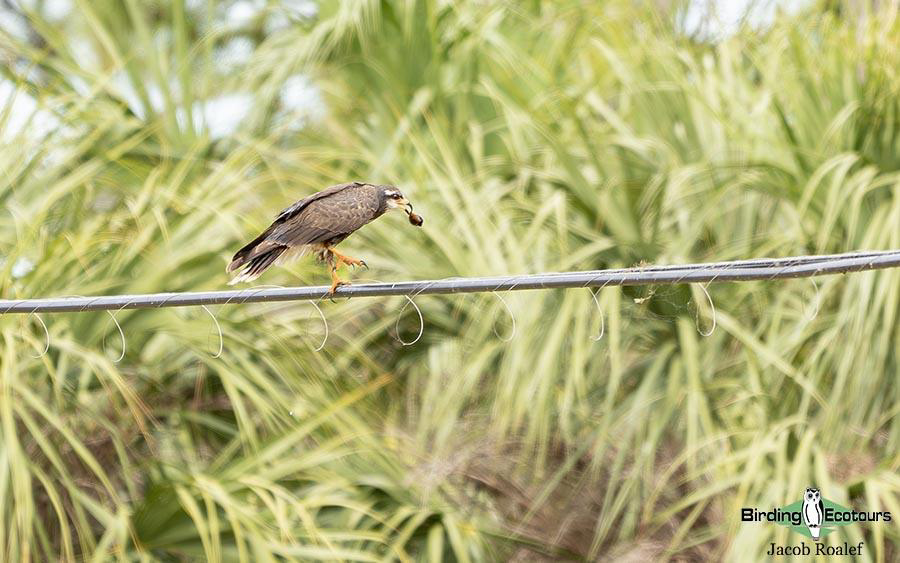
It was fantastic to watch this Snail Kite hunt the canal below.
Day 4, 30th April 2024. Babcock-Webb and the Tamiami Trail
This morning, we departed for the Florida slash pine habitat of Babcock-Webb Wildlife Management Area. The unique habitat here gave us a shot at many new and interesting species for the trip. Early on we heard the calls of Northern Bobwhite and Eastern Meadowlark, both of which played hard to get for visuals, but we lucked into nice views of each after a while. Thankfully it didn’t take long to get onto our top target of the area, the Red-cockaded Woodpecker. We were treated to some stellar views of family, with one even working the pine right next to the road in the gorgeous morning light! After the woodpecker, we began to focus on some other key breeding species in the pine forests. We checked off Brown-headed Nuthatch, Pine Warbler, Eastern Towhee, Northern Flicker, and Eastern Bluebird. There was still one pesky target left, so we pressed on for a bit and heard one singing in the distance. After some careful searching, we all managed some excellent scope views of the singing Bachman’s Sparrow, a notoriously sneaky species. We left the slash pines behind and headed south towards the coast, as we had a lot of ground to cover today. Our next stop was Carlos Pointe on Lover’s Key, a small sandy beach behind some large hotels, that acts as an oasis for shorebirds, herons, gulls, and terns. Unfortunately, the area was undergoing some major construction this year, but a little sweet talking to the supervisors allowed us about 20-30 minutes of access to the beach, and it did not disappoint. Right away we were treated to views of Reddish Egret, Osprey, Grey (Black-bellied), Wilson’s, and Snowy Plovers, and Sanderling. There were plenty of birds to scan through and, after some more careful searching, we noted Least Sandpiper, Hudsonian Whimbrel, Willet, Least Tern, and Black Skimmer, among others. Our time was quickly running out, so we hiked back to the vehicle and continued south to our lunch at a local café.
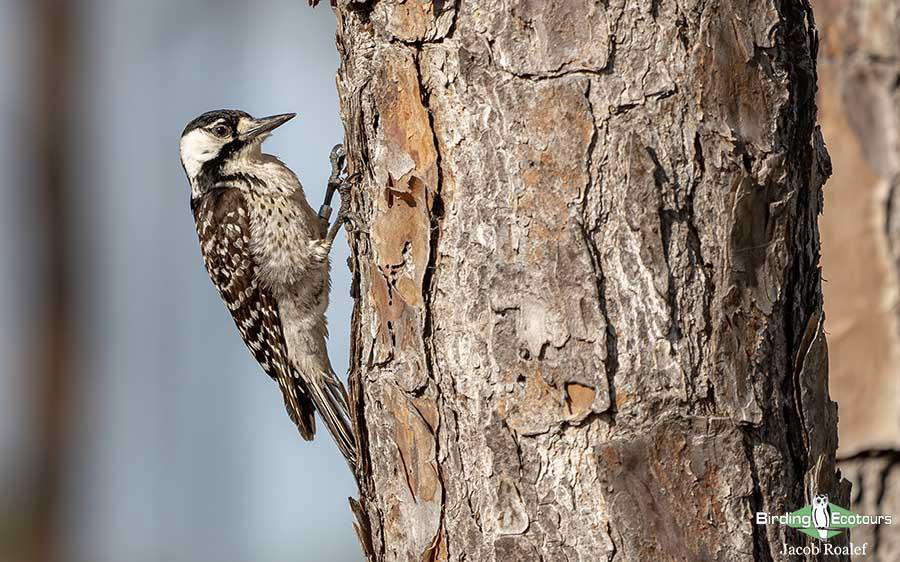
We scored some incredible close-up views of this Red-cockaded Woodpecker.
After lunch we did a quick drive through some waterfront communities in Naples. This netted us a Brown Thrasher, new for the trip, but otherwise it was quite underwhelming. We didn’t spend long here, as we still had about 110 miles (177 kilometers) left to cover along the Tamiami Trail before reaching our hotel for the evening. This drive took us through some of the Cypress Swamps of south Florida. We made a quick stop and explored a small boardwalk at Big Cypress National Preserve. As soon as we exited the vehicle, a pair of Roseate Spoonbills flew overhead. We also noted Wood Stork, Red-shouldered Hawk, and a few American Alligators. As the day started to turn closer to dusk, we scanned the canals next to the road and eventually discovered a Black-crowned Night-Heron,as well as many Snowy Egrets. We continued along the Tamiami Trail, stopping whenever possible to scan. This strategy netted us Black-necked Stilt, Tricolored Heron, and Semipalmated Plover. Eventually we rolled into Homestead, checked into the hotel, and headed off for a tasty dinner in town.
Day 5, 1st May 2024. Everglades National Park and Homestead area
After an early breakfast we headed out for a day in the Everglades. Just outside of the park is a canal area that is typically good for birding, so we made a quick stop here. In our brief visit we found Western Kingbird, American Redstart, White-tailed Kite, and American Crow. We entered the park and enjoyed the scenic drive through the glades. Along the road we scored our best views of the Florida subspecies of Red-shouldered Hawk, plus some great views of Swallow-tailed Kite. In some of the wet areas, we found some secretive Common Yellowthroats and some noisy Red-winged Blackbirds. Eventually we made it to the end of the road known as Flamingo Campground. Here we checked out the marina area and were treated to a West Indian Manatee next to the docks. We continued to the amphitheater area and managed to spot a few birds just before it began raining. Species included Pileated Woodpecker, Dunlin, Western Cattle Egret, American White Pelican, and White-eyed Vireo. The rain provided an excellent time for us to enjoy a picnic lunch in the vehicle.
After we ate, we began the long drive back out of the park. The rain cleared up and we made a stop along the Po-Hay-Okee Overlook to enjoy an excellent view of the glades. Along the boardwalk we also noted a few species like Northern Parula and Blackpoll Warbler. After a short stop at the welcome center, we exited the park and drove along some agricultural fields nearby. Here we picked up some blackbirds and managed to pick out all three species of cowbird! Brown-headed, Bronzed, and the rare Shiny Cowbird were all present along the road and allowed for some nice comparison views. It was now time for some delicious fruit shakes, a visit to a Cave Swallow colony and then an afternoon break, after several long and hot birding days. We all enjoyed the rest and reprieve from the heat, then met up again for dinner. After we ate, we headed off for a little night-time birding back at the canal where we had started the day. Just before sunset we got onto a nice mixed flock which included Blackpoll, Cape May Warblers and American Redstart. We had a fantastic and close fly-by of American Barn Owl as it began its evening hunt! We waited a bit longer until it was dark and drove up and down the road until we could hear the distinctive calls of a Chuck-wills-widow calling. We also picked up a trilling Eastern Screech-Owl. A great session of evening birding to cap off our day!
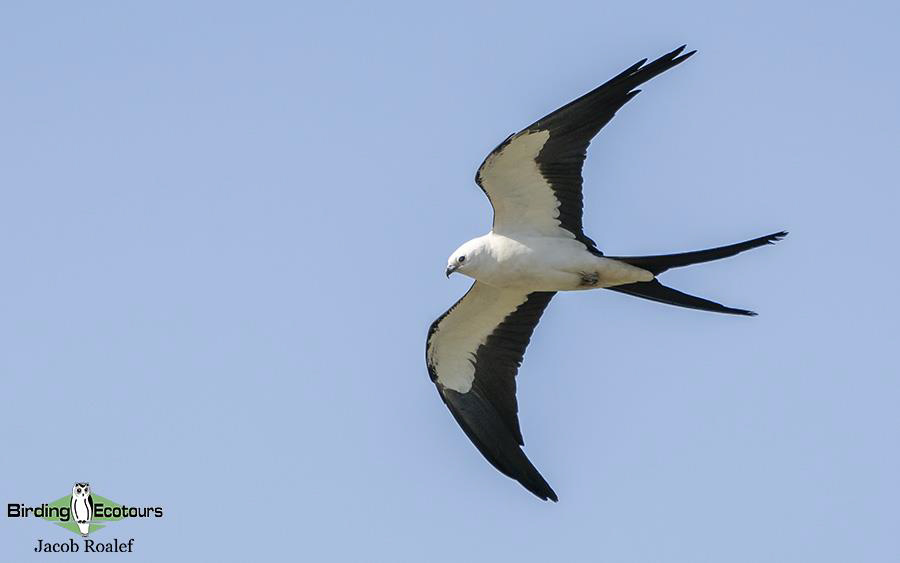
A low soaring Swallow-tailed Kite is always a treat.
Day 6, 2nd May 2024. The Florida Keys
Today we left the mainland behind and crossed into the Florida Keys. Our first stop was Dagny Johnson State Park on Key Largo, the largest of the many keys. We enjoyed a short morning walk through the trees here and had multiple encounters with calling and singing Yellow-billed Cuckoos. We also scored our first looks at White-crowned Pigeon through the tree branches. We left the park and spent a little more time in some secluded areas on Key Largo, where we picked up on a Black-whiskered Vireo, a special species for the region. In addition to the vireo, we also saw another Shiny Cowbird, unusual to be seen on the keys, and a Bobolink, which was new for the trip. It was already mid-morning by the time we finished up here and began one of the most scenic drives in the US, highway 1 in the Florida Keys. We took in the stunning views as we drove over bridge after bridge, before eventually stopping on Long Key for a picnic lunch.
We spent most of the afternoon in the middle keys searching for waterbirds. A stop on Grassy Key yielded a Reddish Egret as well as a pair of Neotropic Cormorants, which is a rarity for here. It was low tide on Ohio Key so plenty of waders and terns were about, like Grey (Black-bellied) Plover, Royal Tern, Ruddy Turnstone, and Great Egret. We continued our drive through the keys, making a detour onto Big Pine Key to search for the famous tiny deer that calls this area home. Located here is the small and endangered subspecies of White-tailed Deer, commonly known as Key Deer. It didn’t take long for us to find a few walking around some neighborhoods here. The day was winding down, so we headed off to Middle Torch Key, a good area for our next target species, the subspecies of Great Blue Heron called Great White Heron. While not a split yet, it does have some potential for a future full species status. We managed to find one in the distance behind some vegetation. From here we finished our drive and arrived at the hotel in Key West where we checked in and headed for dinner. After a tasty dinner near the water, we headed back onto Key West to wait for sunset and hopefully our final target of the day. Thankfully, we didn’t have to wait until it was dark before an Antillean Nighthawk flew overhead, giving its distinctive call. Another great finish to a beautiful day in the Florida Keys.
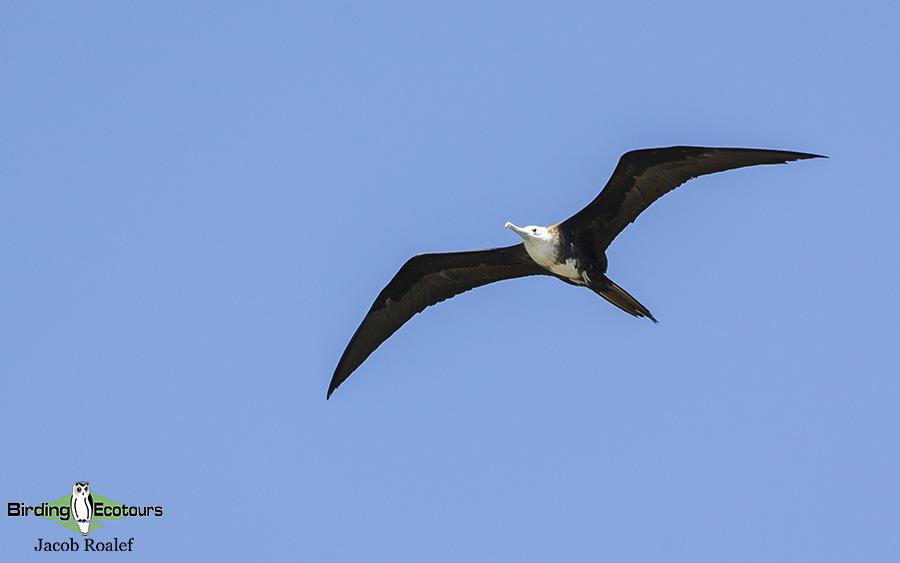
A Magnificent Frigatebird flew over to welcome us to the Keys.
Day 7, 3rd May 2024. Dry Tortugas National Park
This morning was full of excitement and anticipation as we loaded up and headed for the docks to board the ferry to the Dry Tortugas. We enjoyed a little breakfast and coffee onboard the Yankee Freedom as we set sail for our roughly two-hour boat ride. As we approached Fort Jefferson, we got a little closer to the nearby Hospital Key, where we could make out the tiny white spots comprising a Masked Booby colony. We also spotted our first Brown Noddies and Sooty Terns, Garden Key was full of hundreds, maybe even thousands, of these amazing birds! We finally made it to the docks to unload and spend the next five hours or so exploring the island. The standard welcome party of Magnificent Frigatebirds were soaring overhead, and we headed for the interior of the fort. Our first plan was to make it on top of the fort wall to scan the noddy colony. We seemed to trip over Palm Warblers on our way, as they were everywhere today. On top of the wall, we scanned through the loads of noddies and terns and managed to pick out a Roseate Tern mixed in. After about 25 minutes we headed back down and investigated the water drip feature, a great bath and drink stop for migrating songbirds. We relaxed on the benches and watched as Northern Parula, Hooded, Cape May, Palm, and Prairie Warblers, and American Redstart use the bath. From here we headed over to the south coaling docks and discovered a few Bridled Terns perched on the nearby wall, another specialty for the Dry Tortugas. It was then time to head back to the boat for a little air conditioning and to grab our lunches.
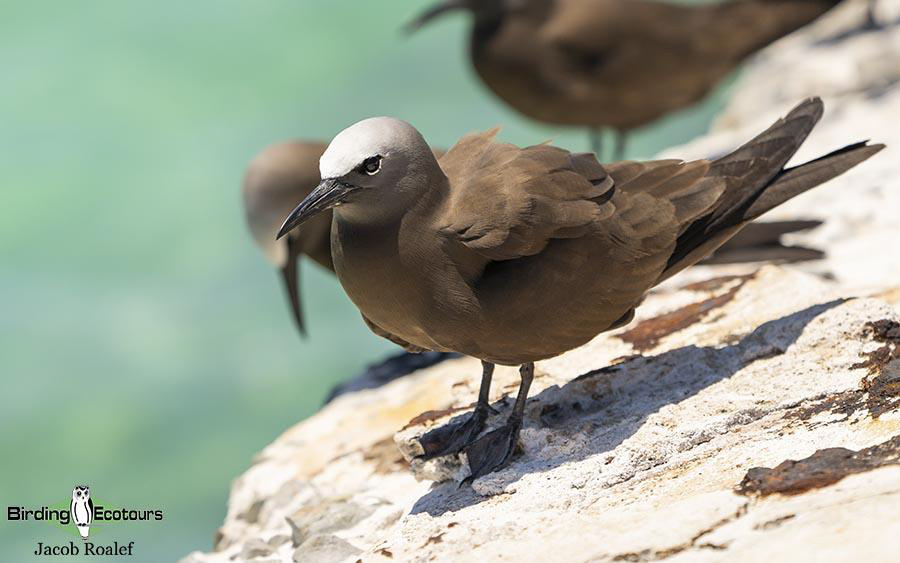
Seeing thousands of Brown Noddies is a top highlight of the Dry Tortugas.
The rest of our time at Dry Tortugas National Park was some free time to wander a bit and check out the nesting Sooty Terns and Brown Noddies, see the visitor’s center, and relax on the benches by the water drip. Some new warblers came into the water while we watched, including Black-throated Blue, Black-and-white, Magnolia, and Blackpoll Warblers. We even had a strange looking Indigo Bunting drop in for a few brief moments. A few of us decided to climb back up the fort wall and do one final scan of the north coaling docks. This decision paid off as we quickly got onto a Black Noddy! One stayed with the bird while I rushed to inform the rest of the group and other birders around. Thankfully the bird stuck around for everyone who wished to see it. After this it was time to load back up and set sail for Key West. After a full day in the sun and about four hours on a boat, everyone was feeling a bit tired. We headed off for dinner and then to the hotel to sleep after an amazing day.
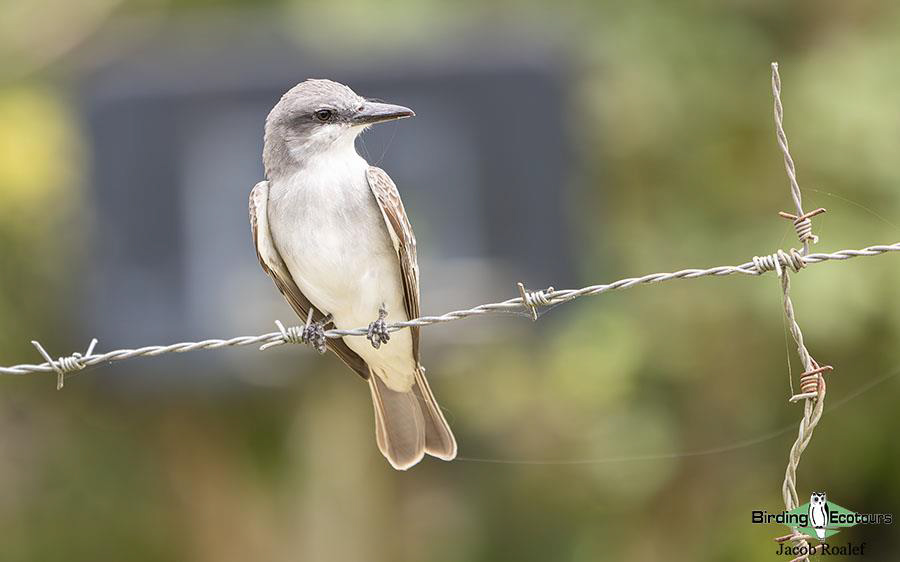
Grey Kingbird was commonly seen throughout the Florida Keys.
Day 8, 4th May 2024. More Florida Keys and back to Homestead
This morning was a little more leisurely, with a later breakfast at our Key West hotel. We then packed our things and headed off for Fort Zachory Taylor State Park for some morning birding. Along the beach in a stand of pines we managed to get onto a nice mixed flock of migrants which included American Redstart, Myrtle, Magnolia, Cape May, and Palm Warblers. A scan of the water yielded Least Tern, Laughing Gull, and Magnificent Frigatebird. From here we headed towards the fort and hiked a little along the trails here. We managed some better views of White-crowned Pigeon, discovered four Bobolinks in the grassland area, and enjoyed a singing Black-whiskered Vireo. On our way out we were treated to excellent views of a Great Blue (White) Heron which was lovely after only distorted views were had on the previous day. It was time to say goodbye to Key West and begin our long journey back out of the Florida Keys. Next stop was the beach along Boca Chica Road. Here we picked up a new trip bird, Yellow-crowed Night-Heron, as well as Short-billed and Long-billed Dowitchers, Willet, Ruddy Turnstone, and Least Sandpiper. By now it was already time for lunch. After enjoying some tasty sandwiches from a local restaurant, it was time to enjoy the long scenic drive out of the Keys. We made one final stop at the Windley Key Fossil Reef Geological State Park to see some interesting coral reef fossils, however the birding was slow in the heat of the day. We loaded back up and headed for our hotel and our final dinner of the trip in Homestead.
Day 9, 5th May 2024. Black Point Marina, Miami, and departure
On our final morning, we decided to do some extra birding since we all had afternoon departures. We still had a few targets left to clean up and today provided an excellent opportunity to go for them. After breakfast we loaded up the vehicle one last time and headed off for Black Point Marina, an area full of mangroves. As we walked along the roadside we noted a few nice species like Yellow-crowned Night-Heron, Downy Woodpecker, and Prairie Warbler. Finally, after about 30 minutes of searching, a Mangrove Cuckoo appeared on the forest edge and allowed us some excellent views before it flew back into the thick trees. Our first target was in the bag and, since it was cooperative, we still had time to go for our second target of the final, the pesky oriole which had alluded us thus far. We headed back into some known neighborhoods in the Miami area where we had looked before. Things were quiet and the birds were much the same as our search on the second day of the trip, White-winged Dove and Blue Jay. Then, as we drove some new streets, two Spot-breasted Orioles appeared and flew right across the road! They landed in an open tree and allowed us all to see them nicely. A perfect cherry on top of what was a fantastic trip! It was then time to head to the airport for drop-offs and to say our goodbyes after going two for two on our final targets of the tour.
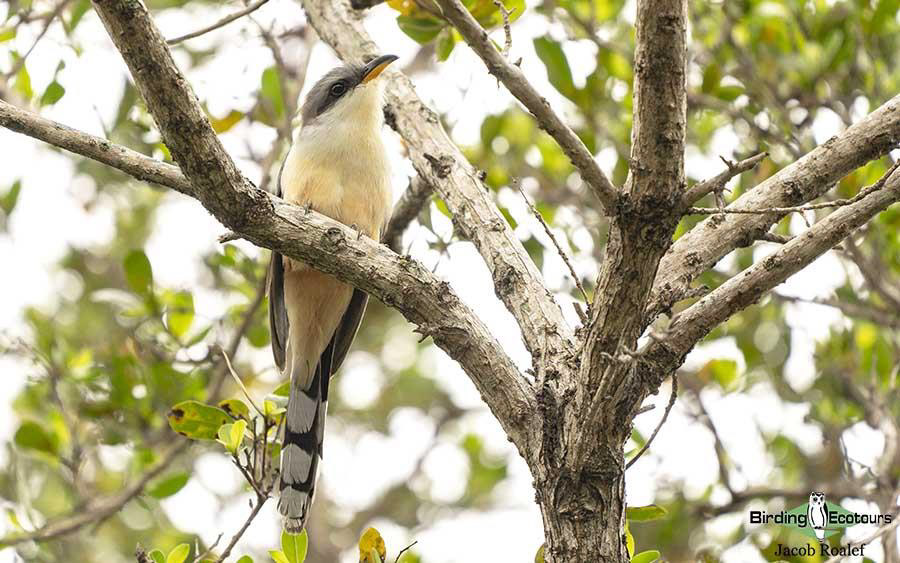
The Mangrove Cuckoo made a last-minute appearance!
Bird List – Following IOC (14.1)
Birds ‘heard only’ are marked with (H) after the common name, all other species were seen.
The following notation after species names is used to show conservation status following BirdLife International: VU = Vulnerable.
| Common Name | Scientific Name |
| Ducks, Geese, Swans (Anatidae) | |
| Black-bellied Whistling Duck | Dendrocygna autumnalis |
| Fulvous Whistling Duck | Dendrocygna bicolor |
| Egyptian Goose | Alopochen aegyptiaca |
| Muscovy Duck | Cairina moschata |
| Wood Duck | Aix sponsa |
| Blue-winged Teal | Spatula discors |
| Ring-necked Duck | Aythya collaris |
| Mottled Duck | Anas fulvigula |
| New World Quail (Odontophoridae) | |
| Northern Bobwhite | Colinus virginianus |
| Pheasants & Allies (Phasianidae) | |
| Wild Turkey | Meleagris gallopavo |
| Indian Peafowl | Centrocercus urophasianus |
| Red Junglefowl | Centrocercus minimus |
| Nightjars (Caprimulgidae) | |
| Common Nighthawk | Chordeiles minor |
| Antillean Nighthawk | Chordeiles gundlachii |
| Chuck-will’s-widow (H) | Antrostomus carolinensis |
| Swifts (Apodidae) | |
| Chimney Swift – VU | Chaetura pelagica |
| Cuckoos (Cuculidae) | |
| Yellow-billed Cuckoo | Coccyzus americanus |
| Mangrove Cuckoo | Coccyzus minor |
| Pigeons, Doves (Columbidae) | |
| Rock Dove (Pigeon) | Columba livia |
| White-crowned Pigeon | Patagioenas leucocephala |
| Eurasian Collared Dove | Streptopelia decaocto |
| Common Ground Dove | Columbina passerina |
| Mourning Dove | Zenaida macroura |
| White-winged Dove | Zenaida asiatica |
| Rails, Crakes & Coots (Rallidae) | |
| Grey-headed Swamphen | Porphyrio poliocephalus |
| Purple Gallinule | Porphyrio martinica |
| Common Gallinule | Gallinula galeata |
| American Coot | Fulica americana |
| Cranes (Gruidae) | |
| Sandhill Crane | Antigone canadensis |
| Limpkin (Aramidae) | |
| Limpkin | Aramus guarauna |
| Grebes (Podicipedidae) | |
| Pied-billed Grebe | Podilymbus podiceps |
| Oystercatchers (Haematopodidae) | |
| American Oystercatcher | Haematopus palliatus |
| Stilts and Avocets (Recurvirostridae) | |
| Black-necked Stilt | Himantopus mexicanus |
| Plovers (Charadriidae) | |
| Grey (Black-bellied) Plover | Pluvialis squatarola |
| Semipalmated Plover | Charadrius semipalmatus |
| Wilson’s Plover | Charadrius wilsonia |
| Killdeer | Charadrius vociferus |
| Snowy Plover | Charadrius nivosus |
| Sandpipers, Snipes (Scolopacidae) | |
| Whimbrel | Numenius phaeopus |
| Ruddy Turnstone | Arenaria interpres |
| Sanderling | Calidris alba |
| Dunlin | Calidris alpina |
| Least Sandpiper | Calidris minutilla |
| Long-billed Dowitcher | Limnodromus scolopaceus |
| Short-billed Dowitcher | Limnodromus griseus |
| Spotted Sandpiper | Actitis macularius |
| Solitary Sandpiper | Tringa solitaria |
| Lesser Yellowlegs | Tringa flavipes |
| Willet | Tringa semipalmata |
| Greater Yellowlegs | Tringa melanoleuca |
| Gulls, Terns, Skimmers (Laridae) | |
| Brown Noddy | Anous stolidus |
| Black Noddy | Anous minutus |
| Black Skimmer | Rynchops niger |
| Laughing Gull | Leucophaeus atricilla |
| Royal Tern | Thalasseus maximus |
| Least Tern | Sternula antillarum |
| Bridled Tern | Onychoprion anaethetus |
| Sooty Tern | Onychoprion fuscatus |
| Roseate Tern | Sterna dougallii |
| Storks (Ciconiidae) | |
| Wood Stork | Mycteria americana |
| Frigatebirds (Fregatidae) | |
| Magnificent Frigatebird | Fregata magnificens |
| Gannets, Boobies (Sulidae) | |
| Masked Booby | Sula dactylatra |
| Cormorants and Shags (Phalacrocoracidae) | |
| Neotropic Cormorant | Nannopterum brasilianum |
| Double-crested Cormorant | Nannopterum auritum |
| Anhingas, Darters (Anhingidae) | |
| Anhinga | Anhinga anhinga |
| Ibises, Spoonbills (Threskiornithidae) | |
| American White Ibis | Eudocimus albus |
| Glossy Ibis | Plegadis falcinellus |
| Roseate Spoonbill | Platalea ajaja |
| Herons, Bitterns (Ardeidae) | |
| Least Bittern | Ixobrychus exilis |
| Black-crowned Night Heron | Nycticorax nycticorax |
| Yellow-crowned Night Heron | Nyctanassa violacea |
| Green Heron | Butorides virescens |
| Western Cattle Egret | Bubulcus ibis |
| Great Blue Heron | Ardea herodias |
| Great Egret | Ardea alba |
| Reddish Egret | Egretta rufescens |
| Tricolored Heron | Egretta tricolor |
| Little Blue Heron | Egretta caerulea |
| Snowy Egret | Egretta thula |
| Pelicans (Pelecanidae) | |
| American White Pelican | Pelecanus erythrorhynchos |
| Brown Pelican | Pelecanus occidentalis |
| New World Vultures (Cathartidae) | |
| Black Vulture | Coragyps atratus |
| Turkey Vulture | Cathartes aura |
| Ospreys (Pandionidae) | |
| Western Osprey | Pandion haliaetus |
| Kites, Hawks, Eagles (Accipitridae) | |
| White-tailed Kite | Elanus leucurus |
| Swallow-tailed Kite | Elanoides forficatus |
| Sharp-shinned Hawk | Accipiter striatus |
| Cooper’s Hawk | Accipiter cooperii |
| Bald Eagle | Haliaeetus leucocephalus |
| Snail Kite | Rostrhamus sociabilis |
| Red-shouldered Hawk | Buteo lineatus |
| Broad-winged Hawk | Buteo platypterus |
| Barn Owls (Tytonidae) | |
| American Barn Owl | Tyto furcata |
| Owls (Strigidae) | |
| Eastern Screech Owl (H) | Megascops asio |
| Burrowing Owl | Athene cunicularia |
| Kingfishers (Alcedinidae) | |
| Belted Kingfisher | Megaceryle alcyon |
| Woodpeckers (Picidae) | |
| Red-bellied Woodpecker | Melanerpes carolinus |
| Downy Woodpecker | Dryobates pubescens |
| Red-cockaded Woodpecker | Leuconotopicus borealis |
| Northern Flicker | Colaptes auratus |
| Pileated Woodpecker | Dryocopus pileatus |
| Caracaras, Falcons (Falconidae) | |
| American Kestrel | Falco sparverius |
| African & New World Parrots (Psittacidae) | |
| Monk Parakeet | Myiopsitta monachus |
| Yellow-chevroned Parakeet | Brotogeris chiriri |
| Blue-and-yellow Macaw | Ara ararauna |
| Mitred Parakeet | Psittacara mitratus |
| Red-masked Parakeet | Psittacara erythrogenys |
| Tyrant Flycatchers (Tyrannidae) | |
| Western Kingbird | Tyrannus verticalis |
| Grey Kingbird | Tyrannus dominicensis |
| Great Crested Flycatcher | Myiarchus crinitus |
| Shrikes (Laniidae) | |
| Loggerhead Shrike | Lanius ludovicianus |
| Vireos, Shrike-Babblers, and Erpornis (Vireonidae) | |
| White-eyed Vireo | Vireo griseus |
| Black-whiskered Vireo | Vireo altiloquus |
| Crows, Jays, and Magpies (Corvidae) | |
| Blue Jay | Cyanocitta cristata |
| Florida Scrub Jay (Endemic) – VU | Aphelocoma coerulescens |
| American Crow | Corvus brachyrhynchos |
| Fish Crow | Corvus ossifragus |
| Swallows (Hirundinidae) | |
| Tree Swallow | Tachycineta bicolor |
| Purple Martin | Progne subis |
| Northern Rough-winged Swallow | Stelgidopteryx serripennis |
| Barn Swallow | Hirundo rustica |
| Cave Swallow | Petrochelidon fulva |
| Wrens (Troglodytidae) | |
| Carolina Wren | Thryothorus ludovicianus |
| Nuthatches (Sittidae) | |
| Brown-headed Nuthatch | Sitta pusilla |
| Mockingbirds, Thrashers (Mimidae) | |
| Grey Catbird | Salpinctes obsoletus |
| Northern Mockingbird | Catherpes mexicanus |
| Brown Thrasher | Cistothorus palustris |
| Starlings, Rhabdornis (Sturnidae) | |
| Common Myna | Acridotheres tristis |
| Common (European) Starling | Sturnus vulgaris |
| Thrushes (Turdidae) | |
| Eastern Bluebird | Sialia sialis |
| Old World Sparrows, Snowfinches (Passeridae) | |
| House Sparrow | Passer domesticus |
| Waxbills, Munias & Allies (Estrildidae) | |
| Scaly-breasted Munia | Lonchura punctulata |
| New World Sparrows (Passerellidae) | |
| Bachman’s Sparrow | Peucaea aestivalis |
| Eastern Towhee | Pipilo erythrophthalmus |
| Oropendolas, Orioles, Blackbirds (Icteridae) | |
| Bobolink | Dolichonyx oryzivorus |
| Eastern Meadowlark | Sturnella magna |
| Spot-breasted Oriole | Icterus pectoralis |
| Red-winged Blackbird | Agelaius phoeniceus |
| Shiny Cowbird | Molothrus bonariensis |
| Bronzed Cowbird | Molothrus aeneus |
| Brown-headed Cowbird | Molothrus ater |
| Common Grackle | Quiscalus quiscula |
| Boat-tailed Grackle | Quiscalus major |
| New World Warblers (Parulidae) | |
| Black-and-white Warbler | Mniotilta varia |
| Common Yellowthroat | Geothlypis trichas |
| Hooded Warbler | Setophaga citrina |
| American Redstart | Setophaga ruticilla |
| Cape May Warbler | Setophaga tigrina |
| Northern Parula | Setophaga americana |
| Magnolia Warbler | Setophaga magnolia |
| Chestnut-sided Warbler | Setophaga pensylvanica |
| Blackpoll Warbler | Setophaga striata |
| Black-throated Blue Warbler | Setophaga caerulescens |
| Palm Warbler | Setophaga palmarum |
| Pine Warbler | Setophaga pinus |
| Myrtle (Yellow-rumped) Warbler | Setophaga coronata |
| Prairie Warbler | Setophaga discolor |
| Cardinals & Allies (Cardinalidae) | |
| Northern Cardinal | Cardinalis cardinalis |
| Indigo Bunting | Passerina cyanea |
| Total Seen | 157 |
| Total Heard | 2 |
| Total Recorded | 159 |
Mammal List
| Common Name | Scientific Name |
| Rabbits and Hares (Leporidae) | |
| Eastern Cottontail | Sylvilagus floridanus |
| Marsh Rabbit | Sylvilagus palustris |
| Squirrels and Allies (Sciuridae) | |
| Eastern Grey Squirrel | Sciurus carolinensis |
| Raccoons and Allies (Procyonidae) | |
| Northern Raccoon | Procyon lotor |
| True Deer (Cervidae) | |
| White-tailed Deer (Key Deer) | Odocoileus virginianus clavium |
| Manatees (Trichechidae) | |
| West Indian Manatee | Trichechus manatus |
| Dolphins (Delphinidae) | |
| Common Bottlenosed Dolphin | Tursiops truncatus |
| Total seen | 7 |
This is a sample trip report. Please email us ([email protected]) for more trip reports from this destination.
